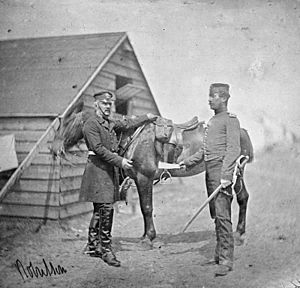Lacy Walter Giles Yea facts for kids
Quick facts for kids
Lacy Yea
|
|
|---|---|
 |
|
| Born | May 20, 1808 Bristol, United Kingdom |
| Died | June 18, 1855 (aged 47) Sevastopol, Russian Empire |
| Buried |
Sevastopol, Russian Empire
|
| Allegiance | United Kingdom |
| Service/ |
British Army |
| Years of service | 1825–1855 |
| Rank | Colonel |
| Commands held | 7th Regiment of Foot 1st Brigade, Light Division |
| Battles/wars | |
| Memorials | Church of St. James, Taunton |
| Alma mater | Eton College |
Lacy Walter Giles Yea (born May 20, 1808 – died June 18, 1855) was a brave British Army officer. He was a colonel who played an important part in the Crimean War. Sadly, he was killed during a battle in that war.
Contents
Early Life and Military Career
Lacy Yea was born in Bristol, England, on May 20, 1808. He was the oldest son of Sir William Walter Yea. His family lived at Pyrland Hall near Taunton, Somerset.
Lacy Yea went to school at Eton College. This is a famous school in England. He joined the army when he was 17 years old. He became an ensign in the 37th Foot regiment in 1825. Over the years, he moved to different regiments. In 1828, he joined the 7th Regiment, known as the Royal Fusiliers. He served with this regiment in places like the Mediterranean and America. He rose through the ranks, becoming a captain in 1836 and a lieutenant-colonel in 1850.
Lacy Yea in the Crimean War
In 1854, Colonel Yea and his Royal Fusiliers regiment went to Turkey. From there, they moved to the Crimea. This was during the Crimean War. Colonel Yea was known for being very strict. He made sure his soldiers were well-trained and disciplined.
The Battle of Alma
At the Battle of Alma, Colonel Yea's regiment was on the right side of the Light Division. They faced a large group of Russian soldiers. The Fusiliers fought bravely against this strong enemy. Even when other parts of their brigade had to fall back, Yea's regiment held its ground. They eventually forced the Russian soldiers to retreat. The regiment suffered many losses, with 12 officers and over 200 men killed or wounded. Colonel Yea received a special letter praising his actions.
The Battle of Inkerman
Later, at the Battle of Inkerman, the Fusiliers were part of a brigade on the slope of Victoria ridge. They helped protect the right side of the British forces. Colonel Yea was mentioned in official reports for his good work. He was promoted to brevet-colonel in November 1854. The winter during the war was very harsh. Despite the difficult conditions, Colonel Yea took great care of his soldiers. He made sure they had what they needed to survive.
The Siege of Sevastopol
In the summer of 1855, Colonel Yea was given command of a brigade. This was during the Siege of Sevastopol. On June 18, 1855, he led an attack on a Russian fort called the Great Redan. His group had to cross a long, open field. They were under heavy fire from Russian cannons. Colonel Yea reached the enemy's defenses with the few soldiers left. There, he was shot and killed.
His body was recovered the next day. He was buried on June 20, 1855, in Sevastopol.
Legacy and Remembrance
Many important leaders praised Colonel Yea for his bravery. Lord Raglan, the British commander, mentioned him in his report. Sir William Codrington also sent his condolences to Yea's sisters.
Colonel Yea was not married. His eldest sister had a marble monument built for him. It is in his local church, St. James's in Taunton, Somerset. A headstone also marked his grave in the cemetery at Sevastopol.
A town in Australia was named in honor of Colonel Yea. This town is called Yea, Victoria.


